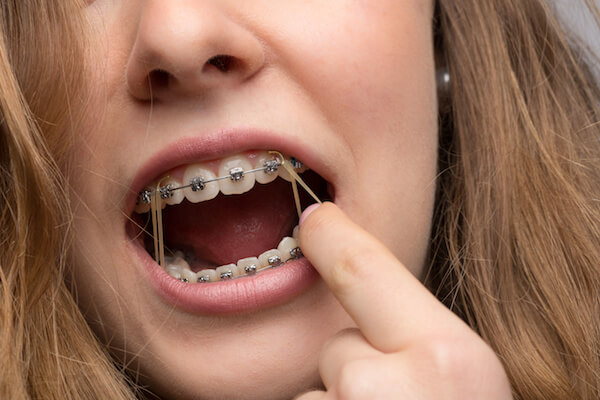
Undergoing orthodontic treatment will change the way you view rubber bands. No longer are these stretchy elastic bands used to hold piles of paper. Instead, they become valuable orthodontic tools that will help you get that perfect smile you have always wanted.
Why are Rubber Bands Needed During Orthodontic Treatment?
In order to get that perfect smile, your teeth will need to shift, rotate, and move into a new position. While brackets and archwire, two types of orthodontic tools, help guide your teeth into their proper position, they don’t provide the force needed to actually correct your bite. That is where the rubber bands come in.
The rubber bands that are applied to the sides of your braces are called interarch rubber bands. They hook up to the brackets on the upper and lower teeth. When they are finally hooked up, they provide just enough force to reposition your jaw and subtly move the teeth in your mouth. Over time, this slight movement of the jaw and teeth will make sure everything lines up properly so you have that perfect smile.
Interarch rubber bands aren’t the only type of rubber bands used during orthodontic treatment. Another type of rubber band, called ligatures, is used by orthodontists. Ligatures are very tiny rubber bands that wrap around the brackets and hold the archwire in place. The ligatures are often people’s favorite part about wearing braces because they come in a variety of colors which allows people to personalize their braces.
How Long Do You Have to Wear Rubber Bands?
The length of time that you have to wear rubber bands will depend upon your individual treatment plan created by your orthodontist. Some people will need to wear interarch rubber bands 24 hours a day, 7 days a week for the entire time they have braces while others may only need to wear them at night or for several hours throughout the day.
The amount of time your orthodontist will recommend you have to wear your interarch rubber bands will depend on the model of your teeth, how much movement needs to be done to your teeth and jaw, and what your goals are for treatment. Your Melbourne, Florida Orthodontist, Dr. Valderrama will be able to give you a general time frame for how long you will wear interarch rubber bands during your consultation.
The ligature rubber bands will need to be worn the entire duration of treatment. Without these bands, the archwire will not be able to be held in place and your teeth will not be moved into their proper positions.
What to Expect When Wearing Rubber Bands with Your Braces
Wearing rubber bands during your course of orthodontic treatment isn’t as bad as it sounds. In fact, after a week or so you won’t even notice that you are wearing rubber bands.
Many patients find understanding what to expect when they wear rubber bands with their braces to be helpful in preparing them for their orthodontic treatment. The following are some common things people can expect to happen when they wear rubber bands with their braces:
- Interarch rubber bands will need to be removed during meals. This will prevent food from getting stuck in the rubber bands.
- Interarch rubber bands will need to be removed when brushing or cleaning your teeth. If the rubber bands were to stay in place while you cleaned your teeth, there would be a number of areas that are missed.
- Interarch rubber bands tend to be replaced on a daily basis. This is because they wear down quickly. Replacing them helps keep the proper amount of force on the teeth and jaw.
- Ligature rubber bands are often changed out during every orthodontic adjustment appointment
- Ligature rubber bands come in a variety of colors ranging from bright neon colors to clear and neutral tones.
If you have any questions about wearing rubber bands during your orthodontic treatment, feel free to call Valderrama Orthodontics. Our friendly office staff will gladly answer any questions you may have about why rubber bands are needed, how to care for your rubber bands, or any other questions you may have about wearing braces.


Let's Get Social